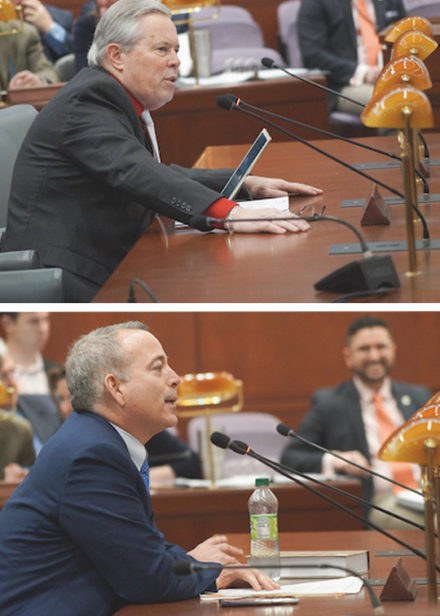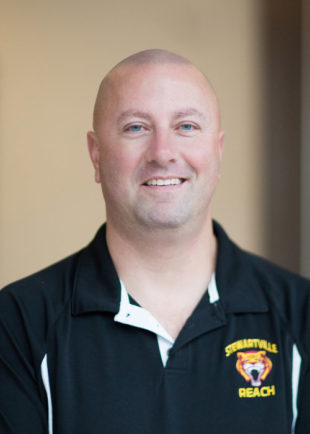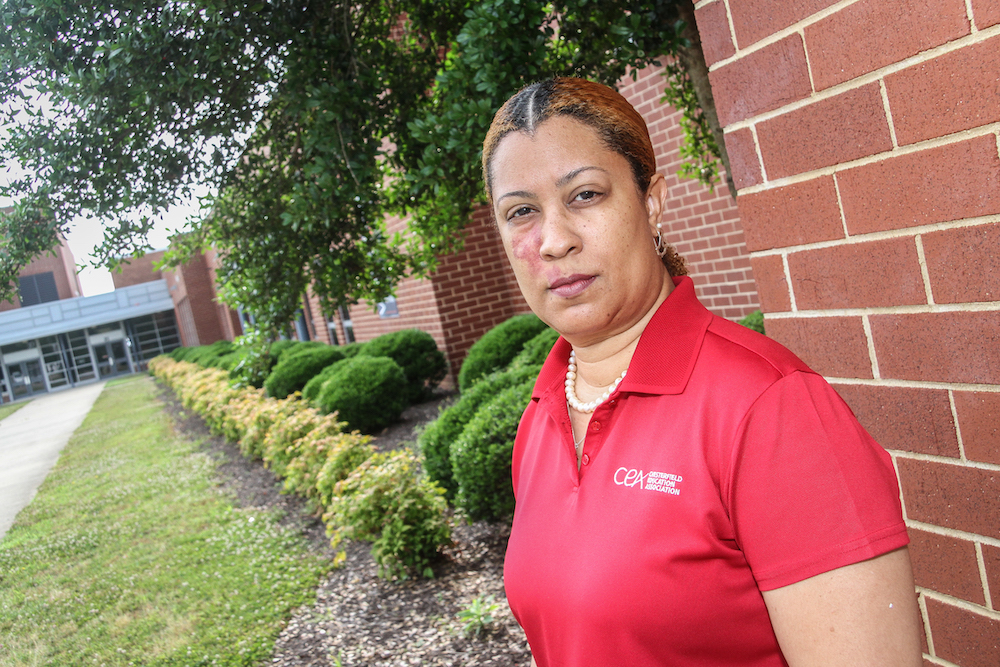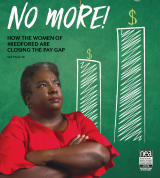The student was extremely upset about something. A paraeducator approached him to inquire. In response, the student kicked her squarely in the stomach. She fell to the floor gasping for air.
Fortunately, Danielle Fragoso and another teacher were in that cooking class last summer. The two teachers had no choice but to try and restrain the student. He began to scream, kick, and punch. Fragoso was hit in an eye.
It got worse. The student eventually grabbed a large chef ’s knife from the counter.
“I was able to grab hold of the hand with the knife right around the wrist area,” Fragoso recalls. “He kept trying to stab me and the other teacher.”
At one point, the student started screaming to no one in particular asking why it seemed so difficult to out-fight two women.
“He was also shouting that he wanted us dead,” says Fragoso, a special education teacher at Daniel Hand High School in Madison, Conn. “After 15 minutes, we finally got the knife away and he ran out of the room without cutting anyone.”
In her 15 years as a teacher, Fragoso was experienced enough to not panic at the sight of a knife-wielding student. She’d been there. A student once stabbed her in the back with a pencil, requiring Fragoso to seek medical attention.
“Luckily there were two of us or the outcome would have been much different,” she says. “My only thoughts were of my students and hoping none of them would get hurt.”
Many teachers, administrators, and education support professionals (ESPs) are at risk of being bitten, kicked, scratched, and punched while at work.
Some assaults are intentional acts of violence while others are the result of, for example, working with students who have mental challenges.
Whatever the circumstances, more and more educators are ending up in the emergency room. While some are forced to use their medical leave, others choose instead to resign.
“Student violence is not as rare an occurrence as most people might think,” Fragoso says.
Classrooms in Crisis
According to a government study on school crime and safety, 10 percent of public school teachers reported being threatened with injury by a student from their school and 6 percent reported being physically attacked by a student from their school.
Published in 2018, “Indicators of School Crime and Safety” was compiled by agencies from the U.S. Departments of Education and Justice.
“Being attacked or threatened in one’s workplace should not happen anywhere, especially in a classroom environment, where we want our students to feel safe and loved,” says Fragoso, who spoke earlier this year at a public hearing conducted by the Connecticut General Assembly.
More than a dozen teachers and Connecticut Education Association (CEA) officials testified to education committee members, while more than 100 others submitted written testimony describing behaviors that create unsafe learning environments for students.
Fragoso, CEA officials, school counselors, and other educators urged lawmakers to address the crisis of violent student behavior which is occurring in rural, urban, and suburban schools. They asked legislators to support House Bill 7110: An Act Concerning Enhanced Classroom Safety and School Climate.
 CEA President Jeff Leake (top) and CEA Vice-President Tom Nicholas testify before Connecticut state lawmakers about classroom and school safety.
CEA President Jeff Leake (top) and CEA Vice-President Tom Nicholas testify before Connecticut state lawmakers about classroom and school safety.
The bill would require schools to help students exhibiting extreme behaviors, provide increased student supports and teacher training, and address children’s mental health and social-emotional needs. Gov. Dannell Malloy vetoed a similar bill last year, but the latest proposal has been updated with more specifics.
Students as young as five are biting, kicking, punching, throwing items, urinating on teachers, and lashing out in other destructive ways that put students and others in danger, Jeff Leake, CEA president, told the committee.
“They are coming to school with complex needs, and schools don’t have the resources to address the root causes of these incidents,” he explained.
“These pieces are key, as too many of our teachers have been pressured to not report or tell others of the incidents that are happening in their classrooms.”
Tom Nicholas is a school social worker and CEA vice president. He described how last school year, in just one month’s time, he had been hit and kicked about 15 times, had a student threaten to kill him with a gun, and fractured three vertebrae trying to protect a student who had run outside the building.
Fragoso testified that she felt supported by her school district administration and was encouraged to speak out to protect her students and colleagues.
“We need systems in place not only to help teachers who are fearful of reporting incidents of threats, and to ensure that they are protected and heard, but also to provide supports and treatment to the students who need help,” she told committee members.
Insufficient Resources
Members of the Bristol-Warren Education Association (BWEA) in Rhode Island organized a sick-out in February to get the attention of school board members as well as state legislators regarding the need for more school resources officers, counselors, and therapeutic services for students.
“For three years, we went through the grievance process asking for interventions for our most needy students,” says Michelle Way DaSilva, BWEA president.
“We do not have sufficient mental health services for students experiencing trauma and who lash out in unpredictable ways.”
DaSilva recalls a recent incident where a kindergarten student hit a teacher in the arm after the teacher asked for the student’s cell phone.
Fortunately, at that age, they are not strong enough to do serious damage. But if they are not disciplined correctly, that behavior will continue as they grow and develop, says DaSilva.
“In middle school, the number of teachers being assaulted and disrespected is getting worse,” she says. “Some of our middle school students are bigger than some teachers, so it is very unsafe for all involved.”
As in schools across the nation, the discontinuation of counselors, paraeducators, social workers, and services for special education and other needy students has only exacerbated the issue.
Earlier this year, the Oregon Education Association (OEA) published, “A Crisis of Disrupted Learning: Conditions in Our Schools and Recommended Solutions.”
Some assaults are intentional acts of violence while others are the result of, for example, working with students who have mental challenges. Whatever the circumstances, more and more educators are ending up in the emergency room. While some are forced to use their medical leave, others choose instead to resign."
According to the report, disrupted learning environments occur “when student behavior significantly interferes with instruction and/or school staff members’ ability to maintain a stable classroom or ensure student safety.” At times, students can become dangerous to themselves or the classroom as a whole. These incidents can often result in clearing a classroom of students to ensure everyone’s safety.
Over three years, OEA members shared stories of extreme behaviors in Oregon schools. According to the report: “These behaviors have made classrooms feel unsafe for students and educators, and everyone is feeling their impact. Student needs are going unmet and educators have very real concerns about whether they can provide safe, welcoming, and inclusive learning environments for all with the resources they have.”
“The issue was not being addressed,” says DaSilva, a teacher for 23 years, the last 21 at Kickemuit Middle School. “So, naturally, it was getting worse.”
In May, DaSilva and BWEA agreed to withdraw several grievances after school administrators signed a memorandum ensuring that viable plans would be put in place.
“We want to get students what they need to be successful,” DaSilva says. “We also want our schools to be safe.”
Reaching Out
In Minnesota, a bill introduced in 2016 would have required school boards to automatically expel a student who threatened or inflicted bodily harm on an educator for up to a year. The bill was introduced in part as a response to a 2015 incident in St. Paul in which a high school student began to strangle a teacher after slamming the teacher into a concrete wall. The teacher suffered a traumatic brain injury.
The bill died in committee after fierce opposition from Education Minnesota (EM) and other state education groups, which instead promote restorative practices as a response to student discipline.
James Parry is the supervisor of the REACH program at Stewartville Middle and High School. The acronym stands for: Relationships, Education, Accountability, Character, Hard Work. The REACH class at Stewartville is an elective for students in seventh through 12th grades. It follows a restorative practices model that helps students to understand and take responsibility for their actions, rather than be punished under zero-tolerance policies. For his part, Parry considers students who may suffer from adverse childhood experiences (ACEs), and the effects of poverty, such as housing or food insecurity.
 James Parry supervises the REACH program at Stewartville Middle and High School.
James Parry supervises the REACH program at Stewartville Middle and High School.
“Just yesterday, I was in our school cafeteria for lunch duty when I heard one of the food service workers scream for help,” Parry recalls from a May incident. “I turned to see two boys in a physical fight, one of them from REACH.”
Parry calmly stepped in between the two students and said: “Really?”
The student in the REACH program later approached Parry.
“He apologized and said he knew he was wrong, but that he just “flipped his lid” in response to remarks from the other student,” Parry says.
“Sometimes conflicts like this are between students and sometimes a teacher is involved.”
The student eventually apologized to the service worker.
“This is unbelievable growth for this student,” says Parry, who was awarded the 2019 EM Human Rights Award. “In REACH, we (adults) focus on things like gratitude, compassion, acceptance, forgiveness, honesty, integrity, and perseverance as a way to connect with students about real life.”
For students, Parry stresses that all people, at whatever age, have stressors in their lives that sometimes get the best of them.
“I identify roadblocks, triggers, and our responses to them,” Parry says.
“It is not any one trigger that makes one “flip their lid” and be aggressive or violent at school.”
It is when these triggers “pile on top of each other that it becomes difficult to control our emotions,” Parry explains.
In his own case, Parry shares with students that any combination of three or four of the following are too much for him: Tired, hungry, thirsty, rushed.
“I am good with one to two of those, but add the third and maybe a
fourth, … it is just too much,” he says.
“We (educators) need to regulate ourselves first if we really want to help our students do the same.”
When discussing restorative practices with teachers, Parry stresses that “when a student comes into the classroom agitated, it is rarely the teacher who has caused this. It is something that happened earlier in the day, at home last night, or something in their near future that they are worried about. We have the power to offer unconditional love and non-judgmental support. Combined, these allow us to put our students in a better mindset to be able to engage in the educational process."
Surveying the Landscape
Sonia Smith is president of the Chesterfield Education Association (CEA) in Virginia. When it comes to students assaulting teachers and ESPs, she fears that many suffer in silence.
“Many do not report assaults from students for fear of retribution from administrators,” says Smith, an English teacher on full-time release with CEA. “Our village is fractured and we need to heal the village.”
In April, a 15-year-old male student threw a backpack and two chairs at a teacher, hitting her in the face and breaking her glasses. She was rushed to the hospital. Days later, another teacher was hurt after a violent incident at another school.
 Sonia Smith (Photo: Luis Gomez)
Sonia Smith (Photo: Luis Gomez)
“After those two incidents, people reached out to me in private,” Smith says. “There are more incidents happening that go unreported. It’s systemic.”
The calls that Smith began receiving prompted her and three other CEA members to create an anonymous online survey to find out who in the district has experienced verbal abuse and violent assaults from students.
“We’re not asking for names,” Smith says. “The goal is to share the findings and collaborate with the school board on implementing solutions.”
The survey is composed of seven multiple-choice questions with text boxes that invite personal stories about past incidents and how administrators responded when told.
“That’s where people open up,” Smith says.
The survey can take as little as three minutes to fill out or more depending on the level of description and number of experiences revealed by the participant.
“I feel good about the survey,” says Shannon Macaulay, an English teacher at Meadowbrook High School. “It means that central office is listening to us.”
Macaulay would like to see more policies in place that are consistently enforced across the board.
“Most of my students are pretty mature and want to graduate so they know how to behave at school,” she says. “But there are some who stare you down, walk out of class when they feel like it, and disrespect you without any consequence from the front office.”
Earlier this year, a female senior student ripped up a quiz in dramatic fashion in one of Macaulay’s classes. After that, she removed a shoe and tossed it at the teacher.
“She reached into her backpack for another shoe and then threw that one at me,” says Macaulay. “It escalated with her kicking a trash can and threatening me.”
After Macaulay called the front office, two security guards restrained the student until the police showed up. The student was handcuffed and driven away.
“This student comes to us with a lot of anger,” Macaulay says. “I have sent emails to administrators out of concern, not blame. But nothing is done.”
In cases like this, Macaulay says the survey gives her hope that district officials will develop policies on how to consistently respond to students under these circumstances.
Smith is already getting calls from the media about when survey results will be released.
“We are going to deal with the data internally at first,” she says. “This is not a public shaming, but if the results will help legislators take action to help out students, then that would be a favorable outcome.”






